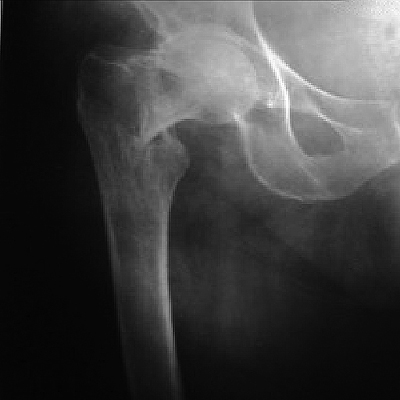Implication of Internal Rotation Traction Radiography in Proximal Femoral Fracture Evaluation
Main Article Content
Abstract
Materials and Method: We consecutively evaluated 100 patients with a diagnosis of proximal femoral fracture. Antero-posterior pelvic radiographs (A-P), A-P radiographs of the affected hip, and internal rotation traction radiographs of the affected hip were taken. A comparison was made between the classifications made by residents and the classification of senior doctors, who used the 3 radiographs to classify all fractures.
Results: The overall agreement score between the initial classification of residents and that of senior doctors was 68.9%. When the resident physicians used internal rotation traction radiography, agreement increased to 78.75%. 51 responses changed with respect to the initial classification. Of these, in 42 (82.4%) cases the initial classification was incorrect and changed to a correct classification. While in 9 (17.6%) cases the initial classification was correct and changed to an incorrect one.
Conclusion: Internal rotation traction radiography is a simple, low-cost study that is well-tolerated by the patient and facilitates correct interpretation of proximal femoral fractures with a direct impact on the choice of treatment and its outcome.Level of Evidence: IV
Downloads
Metrics
Article Details
Manuscript acceptance by the Journal implies the simultaneous non-submission to any other journal or publishing house. The RAAOT is under the Licencia Creative Commnos Atribución-NoComercial-Compartir Obras Derivadas Igual 4.0 Internacional (CC-BY-NC.SA 4.0) (http://creativecommons.org/licences/by-nc-sa/4.0/deed.es). Articles can be shared, copied, distributed, modified, altered, transformed into a derivative work, executed and publicly communicated, provided a) the authors and the original publication (Journal, Publisher and URL) are mentioned, b) they are not used for commercial purposes, c) the same terms of the license are maintained.
In the event that the manuscript is approved for its next publication, the authors retain the copyright and will assign to the journal the rights of publication, edition, reproduction, distribution, exhibition and communication at a national and international level in the different databases. data, repositories and portals.
It is hereby stated that the mentioned manuscript has not been published and that it is not being printed in any other national or foreign journal.
The authors hereby accept the necessary modifications, suggested by the reviewers, in order to adapt the manuscript to the style and publication rules of this Journal.
References
and probability of fracture worldwide. Osteoporos Int 2012;23:2239-56. https://doi.org/10.1007/s00198-012-1964-3
2. Garden RS. Low-angle fixation in fractures of the femoral neck. J Bone Joint Surg Br 1961;43:647-63.
https://doi.org/10.1302/0301-620X.43B4.647
3. Evans EM. The treatment of trochanteric fracture of the femur. J Bone Joint Surg Br 1949;31:190-203.
PMID: 18150534
4. Oakes DA, Jackson KR, Davies MR, Ehrhart KM, Zohman GL, Koval J, et al. The impact of the garden classification on proposed operative treatment. Clin Orthop Relat Res 2003;(409):232-40. https://doi.org/10.1097/01.blo.0000059583.08469.e5
5. Wiltse LL. Internal rotation for the diagnosis of impacted fracture of the hip. Clin Orthop Relat Res 1974;(103):20. https://doi.org/10.1097/00003086-197409000-00008
6. Andersen E, Jorgensen LG, Hededam LT. Evans’ classification of trochanteric fractures: an assessment of the
interobserver and intraobserver reliability. Injury 1990;21(6):377-8. https://doi.org/10.1016/0020-1383(90)90123-C
7. Pervez H, Parker MJ, Pryor GA, Lutchman L, Chirodian N. Classification of trochanteric fracture of the proximal
femur: a study of the reliability of current systems. Injury 2002;33(8):713-5. https://doi.org/10.1016/s0020-1383(02)00089-X
8. Gehrchen PM, Nielsen JO, Olesen B. Poor reproducibility of Evans‘ classification of the trochanteric fracture.
Assessment of 4 observers in 52 cases. Acta Orthop Scand 1993;64(1):71-2. https://doi.org/10.3109/17453679308994533
9. Wiltse LL. Internal rotation for the diagnosis of impacted fracture of the hip. Clin Orthop Relat Res 1974;103:20.
https://doi.org/10.1097/00003086-197409000-00008
10. Koval KJ, Oh CK, Egol KA. Does a traction-internal rotation radiograph help to better evaluate fractures of the
proximal femur? Bull NYU Hosp Jt Dis 2008;66(2):102-6. PMID: 18537778
11. Khurana B, Mandell JC, Rocha TC, Duran-Mendicuti MA, Jimale H, Rosner B, et al. Internal rotation traction
radiograph improves proximal femoral fracture classification accuracy and agreement. AJR Am J Roentgenol 2018; 211(2):409-15. https://doi.org/10.2214/AJR.17.19258

